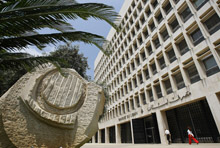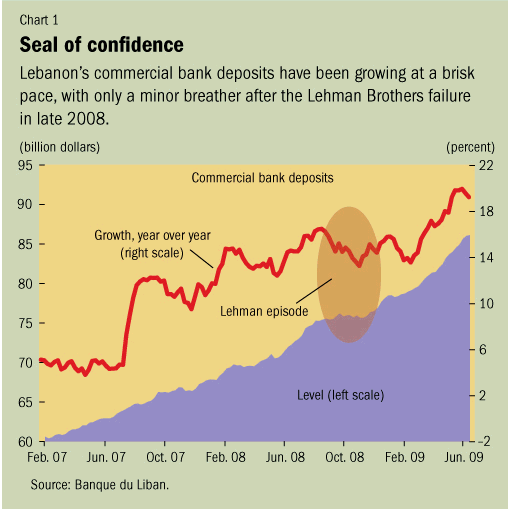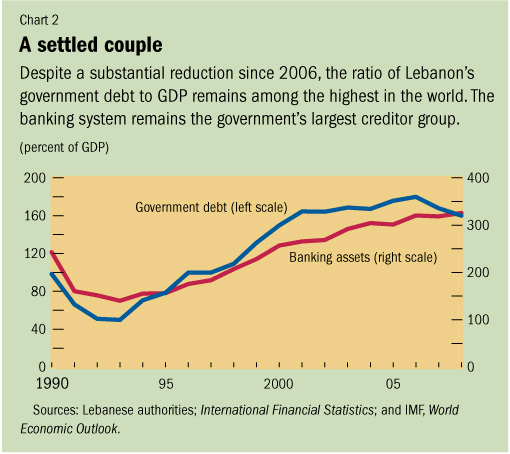
Typical street scene in Santa Ana, El Salvador. (Photo: iStock)
IMF Survey: Resilient Lebanon Defies Odds In Face of Global Crisis
August 11, 2009
- Global crisis, steady improvement in domestic security conditions coincided
- Deposit inflows, small export base mitigate impact of crisis-related downturn
- Top-priority reduction of public debt will require multi-year fiscal discipline
In mid-2008, few would have predicted that 2009 would be a good year for Lebanon.

Central bank in Beirut, Lebanon, where interest rates need to be high enough to attract inflows that assure government financing (photo: Joseph Barrak/AFP)
POST-CONFLICT ASSISTANCE
But while many emerging market countries are deeply embroiled in the global economic crisis, the Lebanese economy could this year grow substantially faster than our recent conservative projection of 4 percent.
Twelve months ago, this rosy scenario seemed unlikely. A fragile national unity government was focusing mainly on maintaining short-term macroeconomic stability and preparing for parliamentary elections—which many saw a possible source of domestic violence—and was in no position to implement major reforms. Then the global financial crisis erupted, and the storm sent Lebanese Eurobond spreads briefly to above 1,200 basis points in October 2008.
With one of the highest government debt-to-GDP ratios in the world, a large and highly dollarized banking system with a significant exposure to the government, and a peg to the dollar, Lebanon has long looked highly vulnerable, and by the time the U.S. investment bank Lehman Brothers failed, Lebanon seemed a prime candidate for a textbook emerging market financial crisis.
Economic resilience
But once more, Lebanon has mocked the doomsayers. Lebanon’s ongoing economic resilience bolstered the banking system, with deposit inflows now growing at nearly 20 percent annually (see Chart 1), and the central bank quickly accumulated international reserves, up 60 percent within a year to the equivalent of almost 70 percent of GDP.

While this resilience is remarkable, it is not the first time in recent years that Lebanon has defied the odds in the face of a severe shock. In 2005, former prime minister Rafik Hariri was assassinated, triggering civil unrest that led to the withdrawal of Syrian troops. In 2006, Hezbollah engaged in a brief but bloody war with Israel. In 2007–08, the country was paralyzed by a political crisis that involved a Hezbollah tent city in downtown Beirut surrounded by armed soldiers, tanks, and barbed wire.
The country was left without a functioning parliament for more than a year. Brief but intense street fighting among opposing militias in May 2008 took the country to the brink of another civil war. And yet Lebanon managed to thrive, an astonishing resilience explained by a combination of structural and contingent factors.
At 160 percent of GDP, Lebanese government debt is staggering, but the government’s structural relationship with the commercial banks bolsters its financing (see Chart 2). Lebanese banks hold the lion’s share of the government’s debt, and have been able for years to increase their exposure thanks to remarkably stable deposit inflows, mostly from the large Lebanese diaspora and foreign investors—typically from the Persian Gulf.

Deposits are also attractive because of high returns made possible by the banks’ portfolio of high-yielding Lebanese government bonds, the professionalism of Lebanese bankers, and Lebanon’s excellent debt service record of no default, even during the civil war of 1975–90. In addition, in difficult times, the international community has helped Lebanon financially to avert crises, thereby also bolstering confidence in the Lebanese banking system.
Liquidity buffers
The banks’ exposure to government clearly increases the system’s structural vulnerabilities, but in the short term also acts as a stabilizing buffer for government financing. During some episodes of political turmoil, deposit withdrawals have been witnessed, even in significant amounts.
But a full-blown debt crisis was averted because banks could resort to their large liquidity buffers to hold on to government debt, and had every incentive to do so as their financial success is closely tied to that of the government. Compared with typical emerging market debt crises where an investor run triggers a downward spiral of government bond prices, this setup has helped soften the impact of confidence losses and has bought time for the situation to turn around and liquidity to resume.
The global crisis
Two additional factors came into play during the current global crisis. First, the crisis coincided with a sustained improvement in domestic security conditions. Following the street fighting in May 2008, a peace agreement brokered in Doha restored calm on the streets and paved the way for the formation of a new government and for parliament to reconvene.
While many observers saw a risk of renewed strife in the runup to parliamentary elections last June, the streets of Beirut have remained reasonably quiet, and many Lebanese are now hopeful that this momentum can be maintained through the critical period of the ongoing negotiations to form a new national unity government.
Looking at Beirut today, the contrast to the pre-Doha situation could not be more striking. Beirut is once again a vibrant city in which people move and spend freely. The tourism industry is quickly recovering from years of domestic security problems, and Arab visitors are now returning in spite of lower crude oil prices affecting many Arabs’ incomes.
Small export base
The second factor that plays relatively in favor of Lebanon lies in its economic structure and policies. The export base is small at 17 percent of GDP, so the downturn in exports as a result of the slump in global demand has not had a major impact on growth.
Remittances have been affected by the global downturn, but so far the negative effect has been small, as relatively few Lebanese expatriates have been laid off and returned home from the Gulf. Bank deposits continue to grow given attractive interest rates and the improved perception of Lebanese banks relative to their Western competitors since the Lehman failure.
Partnership with IMF
The IMF has maintained a close policy dialogue with the Lebanese government, providing policy advice and technical assistance tailored to Lebanon’s needs. Following the 2006 war, the IMF also became part of a concerted international effort to provide financial assistance to Lebanon. Last year, the IMF approved about $37.6 million in Emergency Post-Conflict Assistance (EPCA) to Lebanon in support of the authorities' economic program for 2008–09.
An additional $76.7 million in EPCA was provided to Lebanon in 2007. Lebanon’s IMF-supported program aims to further reduce the government debt-to-GDP ratio, build up the international reserve buffer, and start implementation of key reforms.
The way forward
While Lebanon has once more escaped what many saw as inevitable, there is no guarantee that the country will not fare worse one day if and when the next shock hits. Despite Lebanon’s success in recent years, the wrong set of circumstances could easily translate into severe financial troubles. Hence the case for a decisive reduction of Lebanon’s large vulnerabilities.
Reduction of public debt remains the top priority. This will require many years of sustained fiscal discipline, and will require fixing the electricity sector, a perennial drain on the budget. Maintaining the currency peg will be made easier over time by lower fiscal deficits and public debt.
To maintain financial stability, it is also important to safeguard the health of the large banking sector, by exercising particularly rigorous supervision. This would minimize the likelihood of shocks coming from the banks’ portfolio and the possible propagation to the public debt.
Comments on this article should be sent to imfsurvey@imf.org


